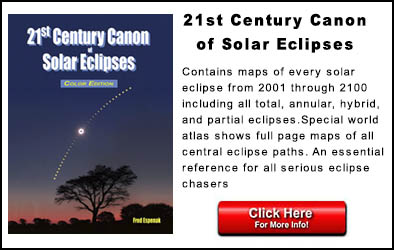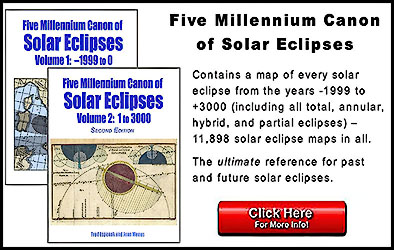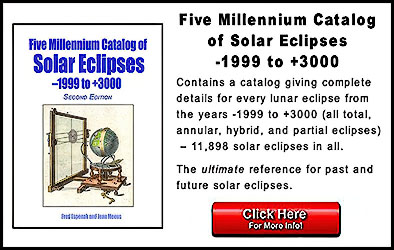Solar Eclipse Basics
Fred Espenak
Based on Thousand Year Canon of Solar Eclipses 1501 to 2500
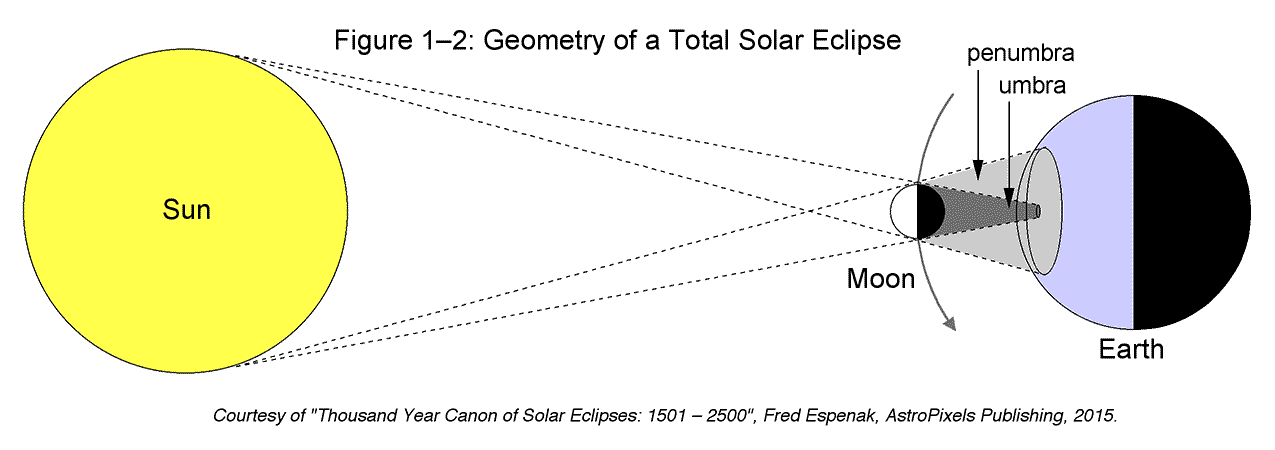
Geometry of a Total Solar Eclipse
A total eclipse is visible within the umbra,
while a partial eclipse is seen within the penumbra.
Solar Eclipse Fundamentals
The Moon orbits Earth once every ∼29.5306 days with respect to the Sun. Over the course of its orbit, the Moon's changing position relative to the Sun results in its familiar phases: New Moon > New Crescent > First Quarter > Waxing Gibbous > Full Moon > Waning Gibbous > Last Quarter > Old Crescent > New Moon. The New Moon phase is not visible because the illuminated side of the Moon points away from Earth. The other phases are easily seen as the Moon cycles through them month after month.
The Moon’s orbit is tilted about 5.1° to Earth’s orbit around the Sun. The apparent points where the two orbits cross are called the nodes. When the New Moon occurs near one of these nodes, the Moon’s shadow can sometimes fall on some portion of Earth and a solar eclipse takes place.
The Moon’s shadow is composed of two cone-shaped components, one nested inside the other. The outer or penumbral shadow is a zone where the Sun's rays are partially blocked. In contrast, the inner or umbral shadow is a region where direct rays from the Sun are completely blocked.
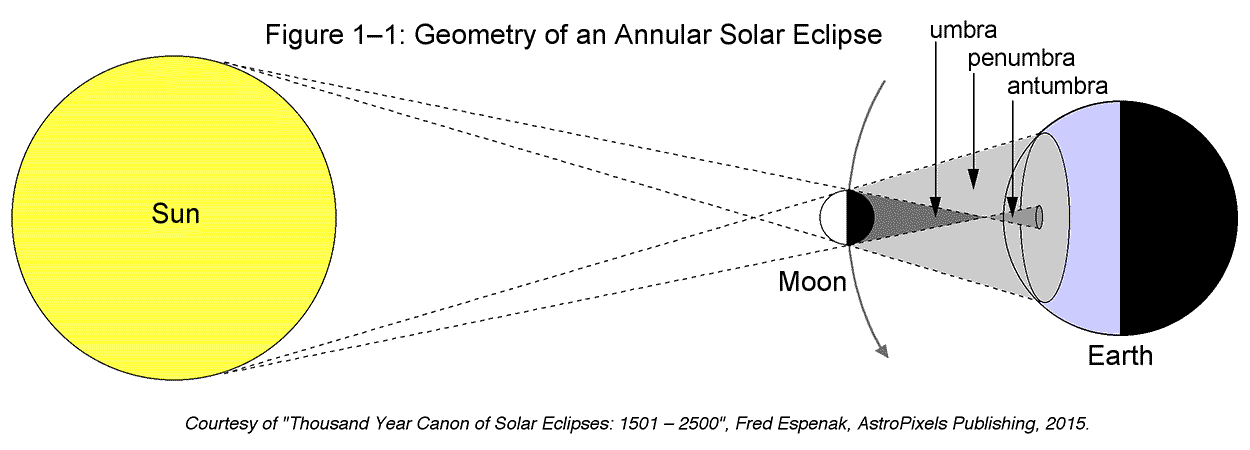
Geometry of an Annular Solar Eclipse
An annular eclipse is visible within the antumbra,
while a partial eclipse is seen within the penumbra.
Types of Solar Eclipses
There are four types of solar eclipses:
- Partial - Moon's penumbral shadow traverses Earth (umbral and antumbral shadows completely miss Earth)
- Annular - Moon's antumbral shadow traverses Earth (Moon is too far from Earth to completely cover the Sun)
- Total - Moon's umbral shadow traverses Earth (Moon is close enough to Earth to completely cover the Sun)
- Hybrid - Moon's umbral and antumbral shadows traverse Earth (eclipse appears annular and total along different sections of its path). Hybrid eclipses are also known as annular-total eclipses.
Total eclipses are visible from within the Moon’s umbral shadow while annular eclipses are seen within the antumbral shadow . These eclipses can be classified as central or non-central as:
- Central (two limits) - The central axis of the Moon’s shadow cone traverses Earth thereby producing a central line in the eclipse track. The umbra or antumbra falls entirely upon Earth so the ground track has both a northern and southern limit.
- Central (one limit) - The central axis of the Moon’s shadow cone traverses Earth. However, a portion of the umbra or antumbra misses Earth throughout the eclipse and the resulting ground track has just one limit.
- Non-Central (one limit) - The central axis of the Moon’s shadow cone misses Earth. However, one edge of the umbra or antumbra grazes Earth thereby producing a ground track with one limit and no central line.
The recurrence of solar eclipses is governed by the Saros cycle. For more information, see Periodicity of Solar Eclipses.
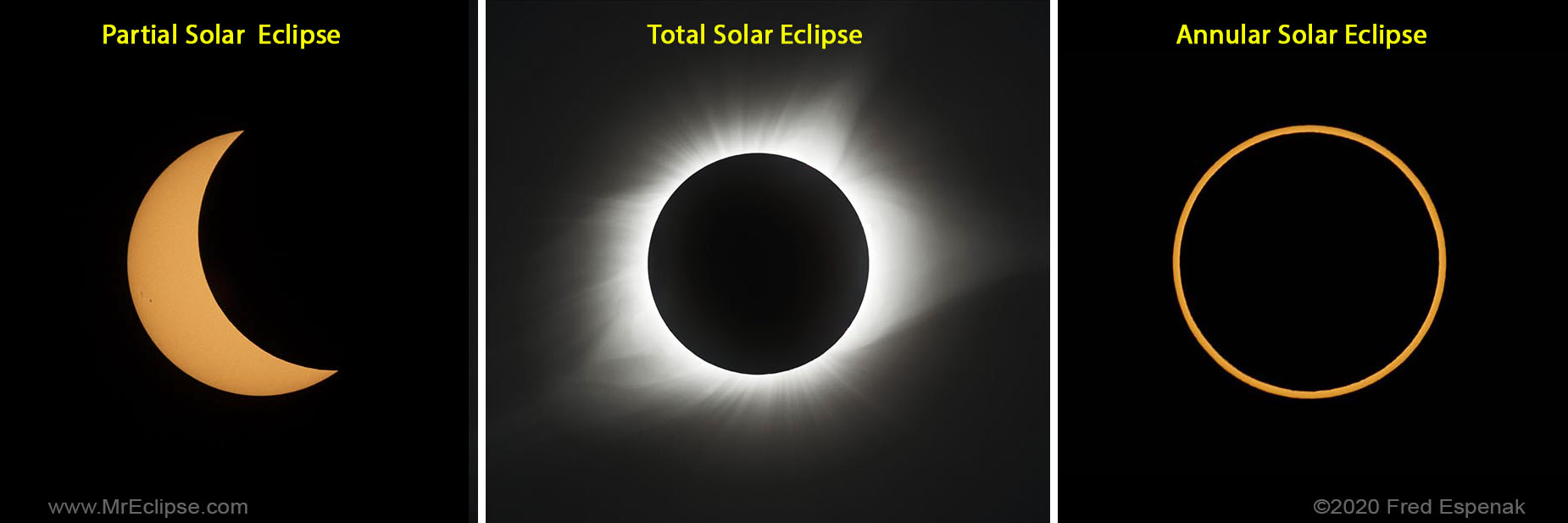
Three Types of Solar Eclipses: Partial, Total, and Annular.
Solar Eclipse Dates
By convention, the date and time used to identify a solar eclipse is the instant of greatest eclipse. This time corresponds to the instant when the axis of the Moon’s shadow passes closest to Earth’s center. For total eclipses, the instant of greatest eclipse is nearly identical to the instant of greatest duration. However, for annular eclipses, the instant of greatest duration may occur either near the time of greatest eclipse or near the sunrise or sunset points of the eclipse path. While the instant of greatest eclipse is used to indentify an eclipse, the eclipse itself generally lasts several hours and may span across two days.
The instant of greatest eclipse is usually expressed in either Terrestrial Dynamical Time (TD) or Universal Time (UT1). The parameter ΔT is used to convert between these two times (i.e., TD = UT1 + ΔT).
Calendar
The Gregorian calendar (also called the Western calendar) is internationally the most widely used civil calendar. It is named for Pope Gregory XIII, who introduced it in 1582. On this website, the Gregorian calendar is used for all calendar dates from 1582 Oct 15 onwards. Before that date, the Julian calendar is used. For more information on this topic, see Calendar Dates.
The Julian calendar does not include the year 0. Thus the year 1 BCE [1] is followed by the year 1 CE (See: BCE/CE Dating Conventions ). This is awkward for arithmetic calculations. Years in this catalog are numbered astronomically and include the year 0. Historians should note there is a difference of one year between astronomical dates and BCE dates. Thus, the astronomical year 0 corresponds to 1 BCE, and astronomical year -1 corresponds to 2 BCE, etc..
Footnotes
[1] The terms BCE and CE are abbreviations for "Before Common Era" and "Common Era," respectively. They are the secular equivalents to the BC and AD dating conventions. (See: Year Dating Conventions )
Links to Solar Eclipse Predictions
- Home - home page of EclipseWise
- Solar Eclipses - primary page for solar eclipse predictions
- Solar Eclipse Links - detailed directory of links
- World Atlas of Solar Eclipse Maps - index page
- Six Millennium Catalog of Solar Eclipses - covers the years -2999 to +3000 (3000 BCE to 3000 CE)
- Javascript Solar Eclipse Explorer - calculate all solar eclipses visible from a city
- MrEclipse.com - eclipse resources and tips on photography
- Solar Eclipses for Beginners - a primer on solar eclipse basics
- How to Photograph a Solar Eclipse - instructions for imaging an eclipse of the Sun
- MrEclipse Photo Index - an index of solar eclipse photographs
Solar Eclipse Publications
- Eclipse Almanac: 2021 to 2030 - all solar and lunar eclipses for the decade
- 21st Century Canon of Solar Eclipses - every solar eclipse from 2001 through 2100
- Thousand Year Canon of Solar Eclipses 1501 to 2500 - basic details about every solar eclipse for 1000 years
- Five Millennium Canon of Solar Eclipses: -1999 to +3000 - the ultimate reference with global maps
- Five Millennium Catalog of Solar Eclipses: -1999 to +3000 - the ultimate reference containing comprehensive tables
Eclipse Predictions
The eclipse predictions presented here were generated using the JPL DE406 solar and lunar ephemerides. The lunar coordinates have been calculated with respect to the Moon’s Center of Mass.
Acknowledgments
Some of the content on this web site is based on the book Thousand Year Canon of Solar Eclipses 1501 to 2500. All eclipse calculations are by Fred Espenak, and he assumes full responsibility for their accuracy. Permission is granted to reproduce data from this page when accompanied by an acknowledgment:
"Eclipse Predictions by Fred Espenak, www.EclipseWise.com"

